Dynamic Responses of Asphalt Concrete Waterproofing Layer in Ballastless Track
Abstract
1. Introduction
2. Materials and Laboratory Evaluation
2.1. Materials
2.2. Laboratory Performance Tests
- High temperature stability
- Anti-fatigue cracking performance
- Low-temperature crack resistance
- Water damage resistance
2.2.1. Rutting Test
2.2.2. Fatigue Test
2.2.3. Low Temperature Bending Test
2.2.4. Water Stability Test
2.2.5. Test Results of Performance Tests
3. Construction of Test Section
3.1. Field Construction of Asphalt Concrete Waterproofing Layer (ACWL)
- The emulsified asphalt was evenly spread on the surface layer of roadbed, namely the graded gravel one day before paving the asphalt mixtures, as shown in Figure 4a.
- The modified asphalt and aggregates were fully mixed in the mixing station and the asphalt mixtures were transported to the construction site by the dump truck, as shown in Figure 4b.
- The asphalt mixtures were paved by the automatic paver and the paver was equipped with the automatic elevation control system to ensure the slope of the ACWL, as shown in Figure 4c.
- The steel-wheel vibratory roller and the rubber-wheel roller were alternately used to compact the paved asphalt concrete, as shown in Figure 4d.
- The traffic, such as the trucks that transported the construction equipment and materials for the adjacent construction sections, was closed after the compacting was completed. The on-site tests were carried out one day later for evaluating the construction quality.
3.2. Field Tests
4. Viscoelastic Model of Asphalt Concrete
4.1. Dynamic Modulus Test and Construction of Master Curve
4.2. Determination of Viscoelastic Parameters Based on Generalized Maxwell Model
5. Numerical Model
5.1. Vehicle Model
5.2. Wheel–Rail Contact Model
5.3. Track Structure Model
5.4. Model Verification
6. Result Analysis and Discussion
6.1. Analysis of Critical Loading Position
6.2. Comparison of Dynamic Responses of Track Structure with and without ACWL
7. Conclusions
- The main technical requirements of asphalt mixture for the ACWL were proposed based on the laboratory tests, including rutting test, fatigue test, low temperature bending test, immersion Marshall test and freeze–thaw split test. A test section of ACWL for the ballastless railway was constructed in north China and the field test results prove that the proposed requirements are reasonable and reliable.
- The viscoelastic properties of asphalt concrete obtained from the ACWL in the test section were investigated based on the dynamic modulus test. The Prony series for the generalized Maxwell is an effective tool to convert dynamic modulus to relaxation modulus in the linear viscoelastic domain, which contributes to the implementation of viscoelastic constitutive relationship in the finite element model.
- The reliability of the developed 3D finite element model was proved by the field measured data. The results indicate that it is unfavorable for the dynamic responses of ACWL when the wheelset is located at the expansion joint of base plates. The tensile strain at the bottom of ACWL is generally at a relatively low level, which means the long service life of ACWL is guaranteed. Additionally, the vertical displacement and vertical stress of each structural layer are obviously reduced due to the application of ACWL in the ballastless track structure.
- The validated 3D finite element model could be the basis for the future studies, such as the parameter sensitivity analysis and the long-term performance of the ACWL in the test section will be continuously monitored.
Author Contributions
Funding
Conflicts of Interest
References
- Fang, R.; Lu, Z.; Yao, H.; Luo, X.; Yang, M. Study on dynamic responses of unsaturated railway subgrade subjected to moving train load. Soil Dyn. Earthq. Eng. 2018, 115, 319–323. [Google Scholar] [CrossRef]
- Lin, Z.; Niu, F.; Li, X.; Li, A.; Liu, M.; Luo, J.; Shao, Z. Characteristics and controlling factors of frost heave in high-speed railway subgrade, Northwest China. Cold Reg. Sci. Technol. 2018, 153, 33–44. [Google Scholar] [CrossRef]
- Chen, X.; Tao, T.; Yang, G.; Yan, H.; Yang, J. Long-Lasting Waterproofing Solution for the Subgrade of High-Speed Railway in Cold Region. J. Test. Eval. 2019, 47, 20180046. [Google Scholar] [CrossRef]
- Momoya, Y.; Sekine, E. Performance-Based Design Method for Railway Asphalt Roadbed. Doboku Gakkai Ronbunshuu E 2007, 63, 608–619. [Google Scholar] [CrossRef]
- Teixeira, P.F.; Ferreira, P.A.; Pita, A.L.; Casas, C.; Bachiller, A. The Use of Bituminous Subballast on Future High-Speed Lines in Spain. Int. J. Railw. 2009, 2, 1–7. [Google Scholar]
- Rose, J.G.; Teixeira, P.F.; Veit, P. International design practices, applications, and performances of asphalt/bituminous railway trackbeds. In Proceedings of the GEORAIL 2011-International Symposium, Paris, France, 19–20 May 2011. [Google Scholar]
- Rose, J.G. Selected In-Track Applications and Performances of Hot-Mix Asphalt Trackbeds. In Proceedings of the 2013 Joint Rail Conference, Knoxville, TN, USA, 15–18 April 2013. V001T01A017. [Google Scholar] [CrossRef]
- Teixeira, P.F.; López Pita, A.; Ferreira, P.A. New possibilities to reduce track costs on high-speed lines using a bituminous sub-ballast layer. Int. J. Pavement Eng. 2010, 11, 301–307. [Google Scholar] [CrossRef]
- Lee, S.-H.; Choi, Y.-T.; Lee, H.-M.; Park, D.-W. Performance evaluation of directly fastened asphalt track using a full-scale test. Constr. Build. Mater. 2016, 113, 404–414. [Google Scholar] [CrossRef]
- Fang, M. Structural Behavior and Mix Design for Asphalt Concrete Substructures in High-speed Rail. Ph.D. Thesis, Southwest Jiaotong University, Chengdu, China, 2012. (In Chinese). [Google Scholar]
- Wang, Z.; Yang, J.; Chen, X. Mastic Asphalt Concrete Waterproof Layer on High-Speed Railway Subgrade in Cold Regions. In Proceedings of the Transportation Research Board 94th Annual Meeting, Washington, DC, USA, 11–15 January 2015; Transportation Research Board: Washington, DC, USA, 2015. (In Chinese). [Google Scholar]
- Liu, S.; Yang, J.; Chen, X.; Wang, M.; Zhou, W. Design of Asphalt Waterproofing Layer for High-Speed Railway Subgrade: A Case Study in Heilongjiang Province, China. In Proceedings of the Transportation Research Board 96th Annual Meeting, Washington, DC, USA, 8–12 January 2017; Transportation Research Board: Washington, DC, USA, 2017. [Google Scholar]
- Liu, S.; Yang, J.; Chen, X.; Yang, G.; Cai, D. Application of Mastic Asphalt Waterproofing Layer in High-Speed Railway Track in Cold Regions. Appl. Sci. 2018, 8, 667. [Google Scholar] [CrossRef]
- Di Mino, G.; Di Liberto, M.; Maggiore, C.; Noto, S. A Dynamic Model of Ballasted Rail Track with Bituminous Sub-Ballast Layer. Procedia Soc. Behav. Sci. 2012, 53, 366–378. [Google Scholar] [CrossRef]
- Ferreira, T.M.; Teixeira, P.F. Rail Track Performance with Different Subballast Solutions: Traffic and Environmental Effects on Subgrade Service Life. J. Transp. Eng. 2012, 138, 1541–1550. [Google Scholar] [CrossRef]
- Ramirez Cardona, D.; Di Benedetto, H.; Sauzeat, C.; Calon, N.; Saussine, G. Use of a bituminous mixture layer in high-speed line trackbeds. Constr. Build. Mater. 2016, 125, 398–407. [Google Scholar] [CrossRef]
- Research Institute of Highway Ministry of Transport. Standard Test Methods of Bitumen and Bituminous Mixtures for Highway Engineering; JTG E20-2011; China Communications Press: Beijing, China, 2011. (In Chinese) [Google Scholar]
- Research Institute of Highway Ministry of Transport. Technical Specifications for Construction of Highway Asphalt Pavements; JTG F40-2004; China Communications Press: Beijing, China, 2004. (In Chinese) [Google Scholar]
- Zhou, W. Study on Railway Asphalt Concrete Substructure under CRTS III Type Ballastless Track. Master’s Thesis, Southeast University, Nanjing, China, 2017. (In Chinese). [Google Scholar]
- Williams, M.L.; Landel, R.F.; Ferry, J.D. The Temperature Dependence of Relaxation Mechanisms in Amorphous Polymers and Other Glass-forming Liquids. J. Am. Chem. Soc. 1955, 77, 3701–3707. [Google Scholar] [CrossRef]
- Luo, R.; Lytton, R.L. Characterization of the Tensile Viscoelastic Properties of an Undamaged Asphalt Mixture. J. Transp. Eng. 2010, 136, 173–180. [Google Scholar] [CrossRef]
- Park, S.W.; Schapery, R.A. Methods of interconversion between linear viscoelastic material functions. Part I—A numerical method based on Prony series. Int. J. Solids Struct. 1999, 36, 1653–1675. [Google Scholar] [CrossRef]
- Zhang, Y.; Birgisson, B.; Lytton, R.L. Weak Form Equation–Based Finite-Element Modeling of Viscoelastic Asphalt Mixtures. J. Mater. Civ. Eng. 2016, 28, 04015115. [Google Scholar] [CrossRef]
- Lei, X.; Wu, S.; Zhang, B. Dynamic Analysis of the High Speed Train and Slab Track Nonlinear Coupling System with the Cross Iteration Algorithm. J. Nonlinear Dyn. 2016, 2016, 1–17. [Google Scholar] [CrossRef]
- National Railway Administration of the People’s Republic of China. Code for Design of High Speed Railway; TB 10621-2014; China Railway Press: Beijing, China, 2014. (In Chinese)
- Chen, J.; Zhou, Y. Dynamic responses of subgrade under double-line high-speed railway. Soil Dyn. Earthq. Eng. 2018, 110, 1–12. [Google Scholar] [CrossRef]
- Wang, M. Study on Dynamic Characteristics of Asphalt Concrete Substructures under CRTS III Type Ballastless Track. Master’s Thesis, Southeast University, Nanjing, China, 2017. (In Chinese). [Google Scholar]


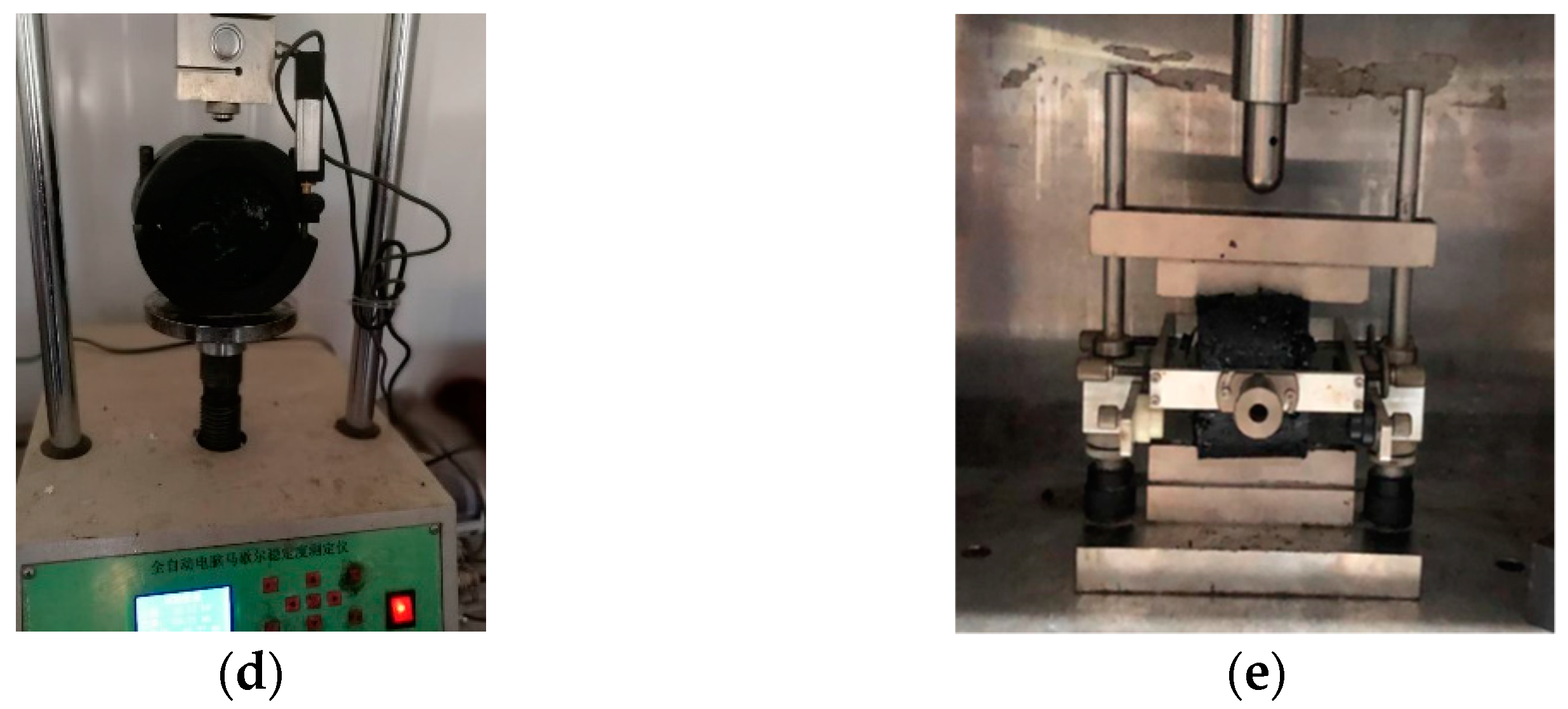

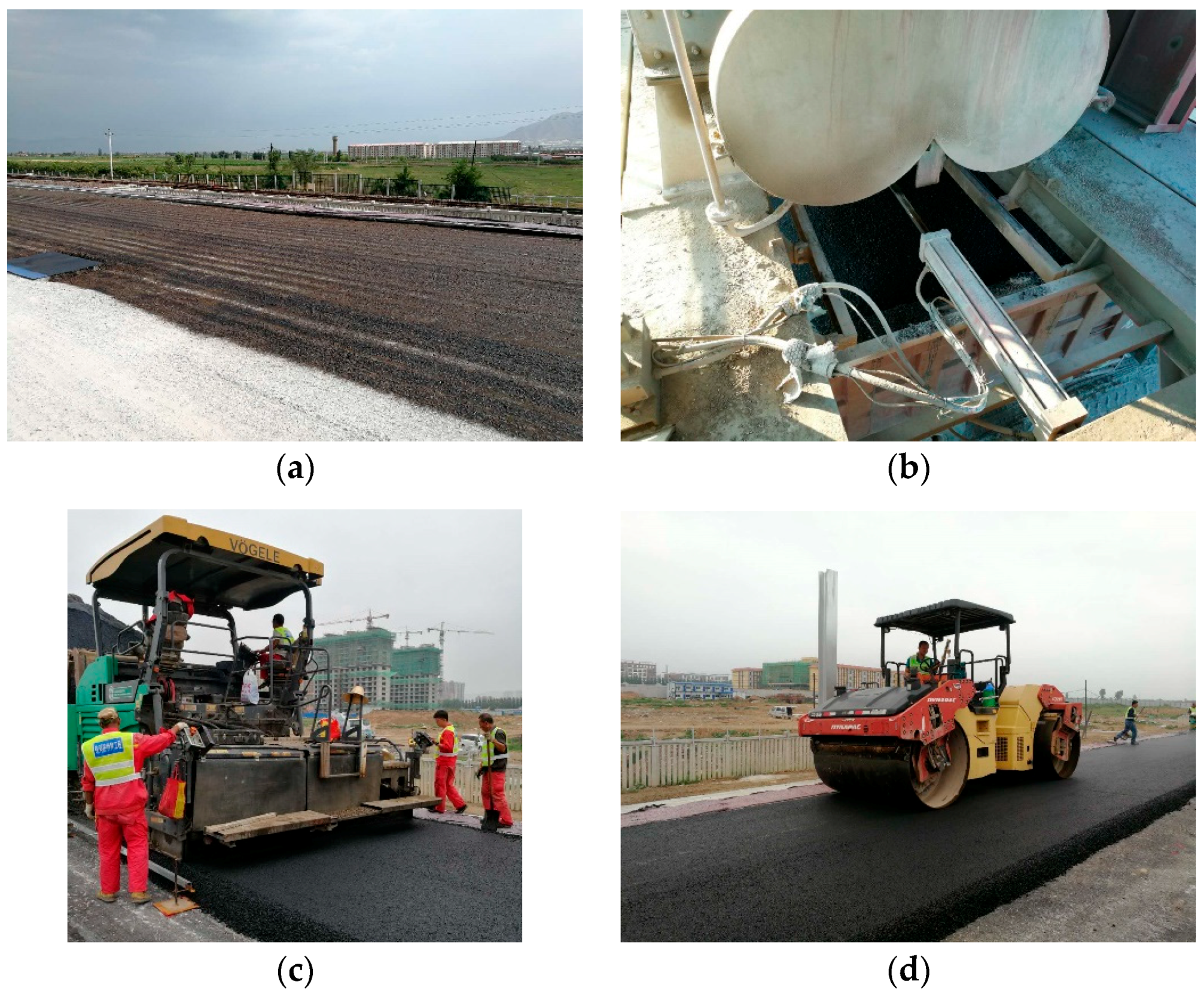
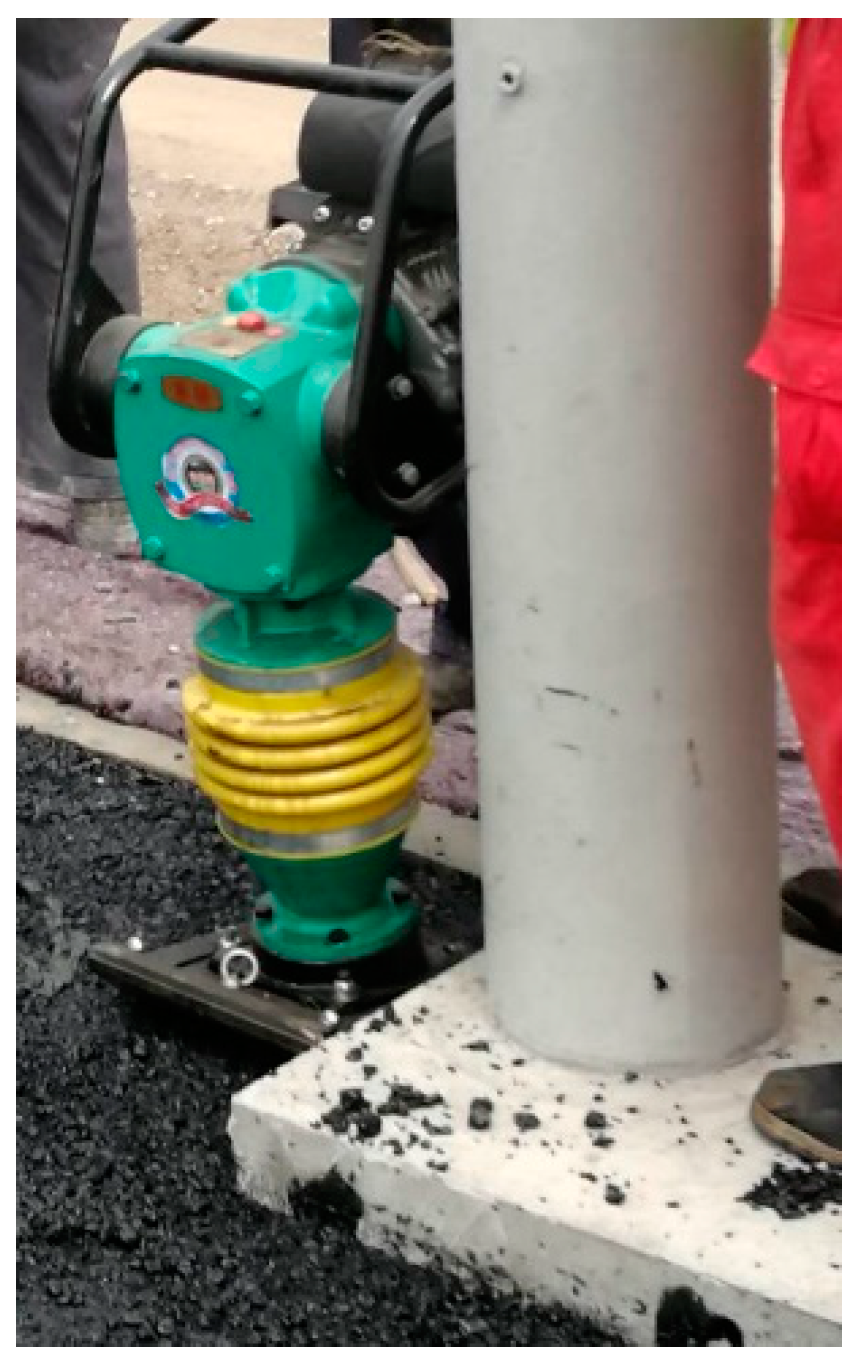
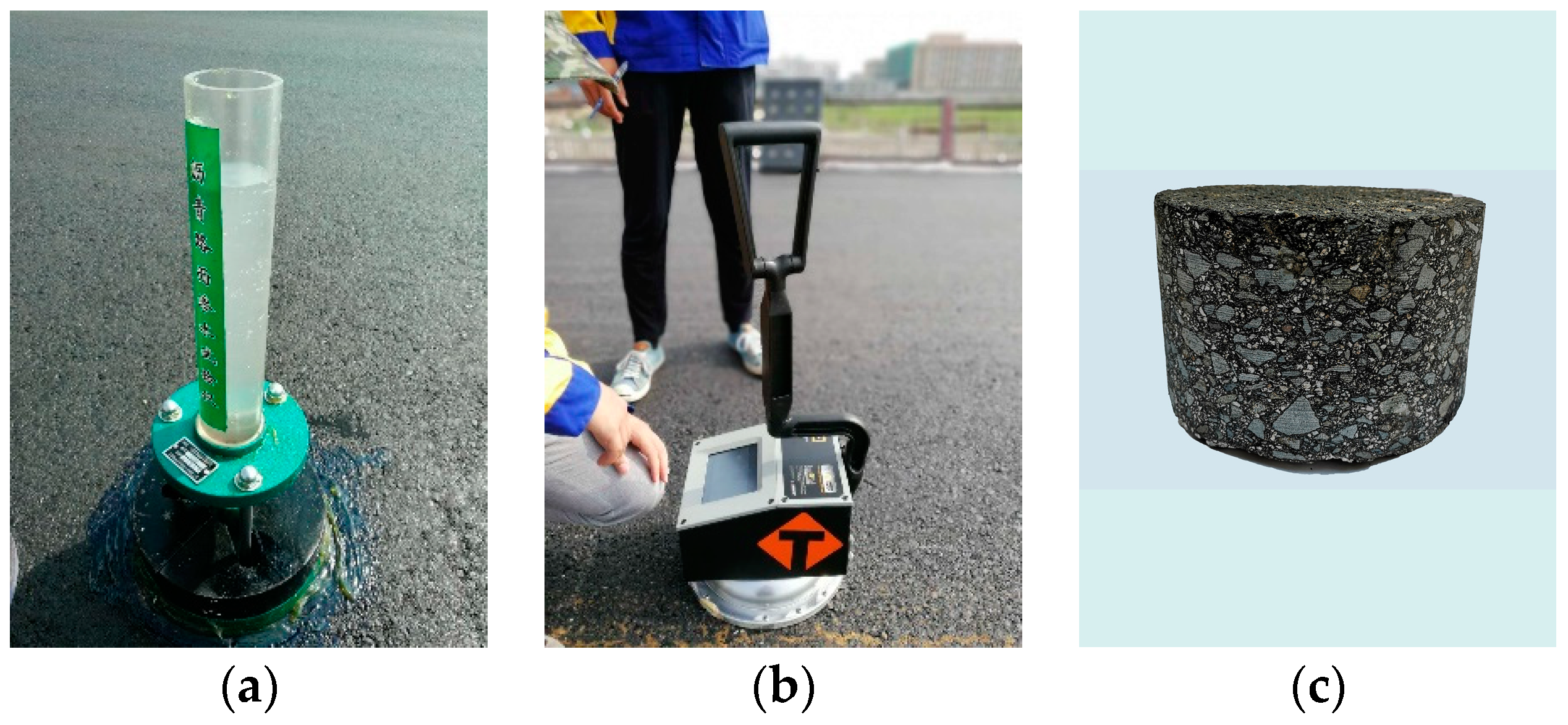

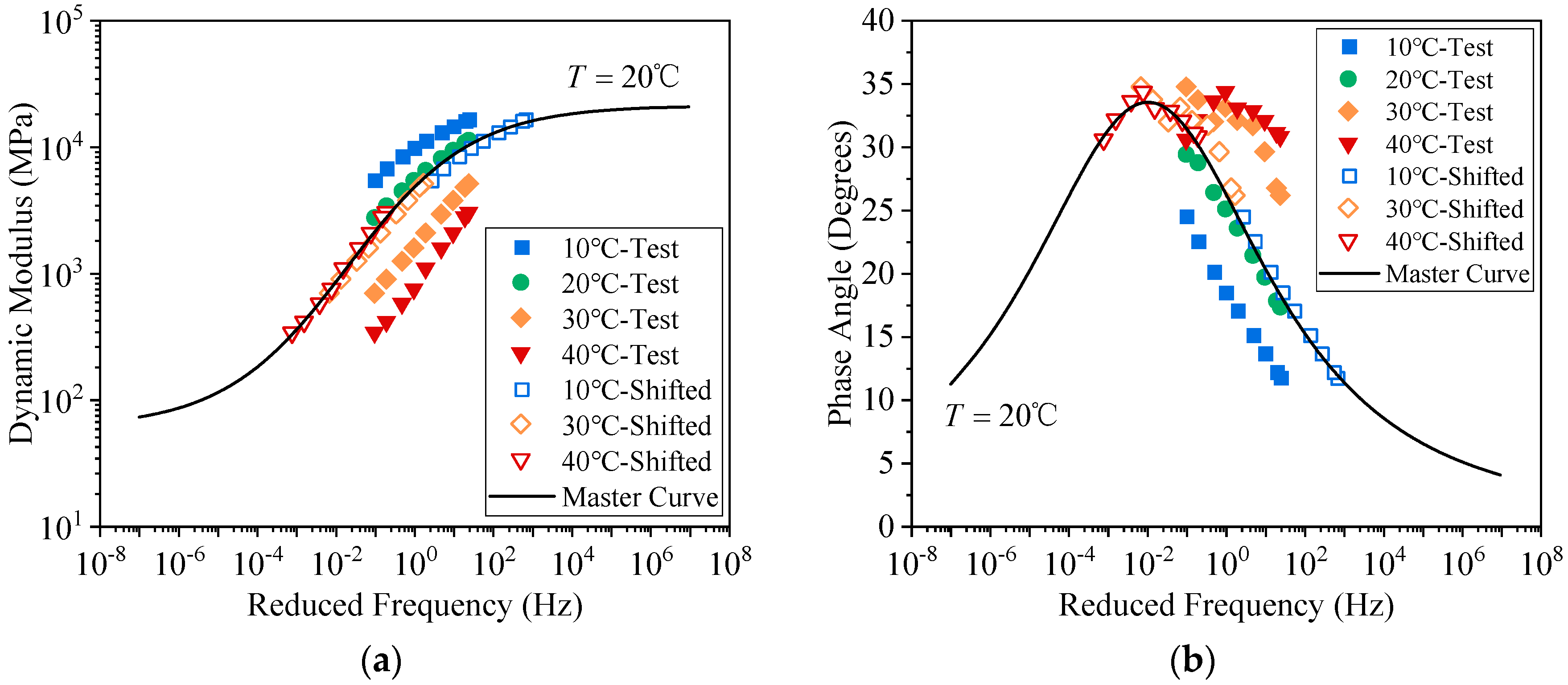

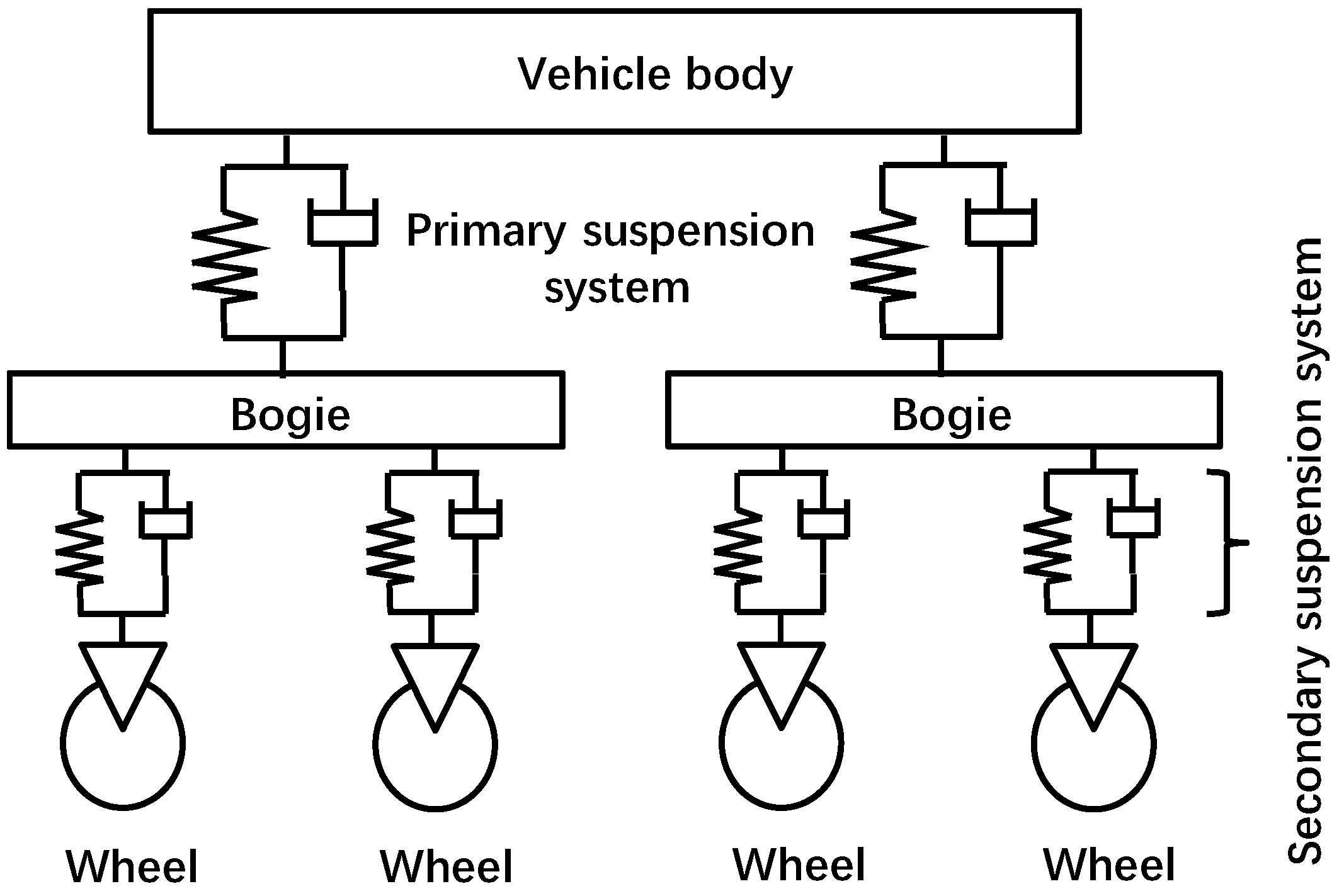
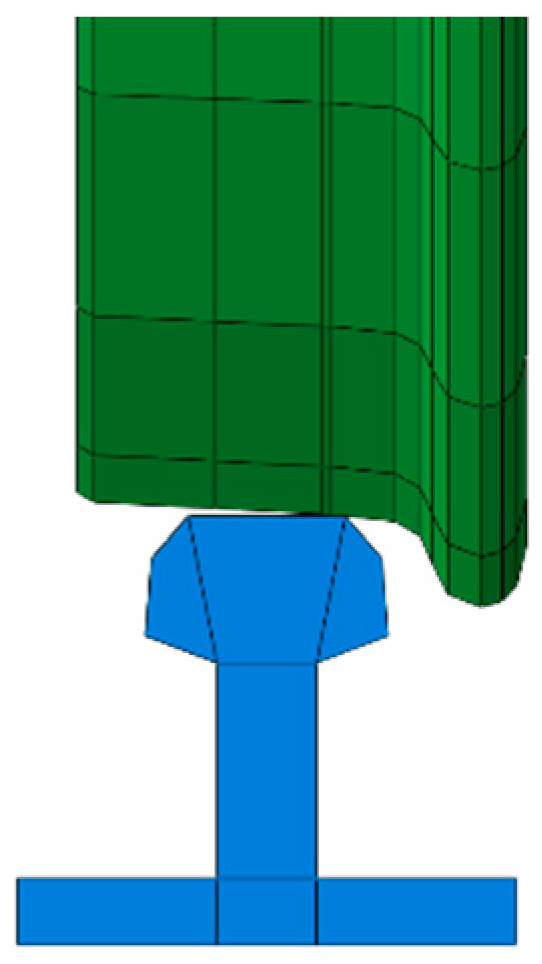
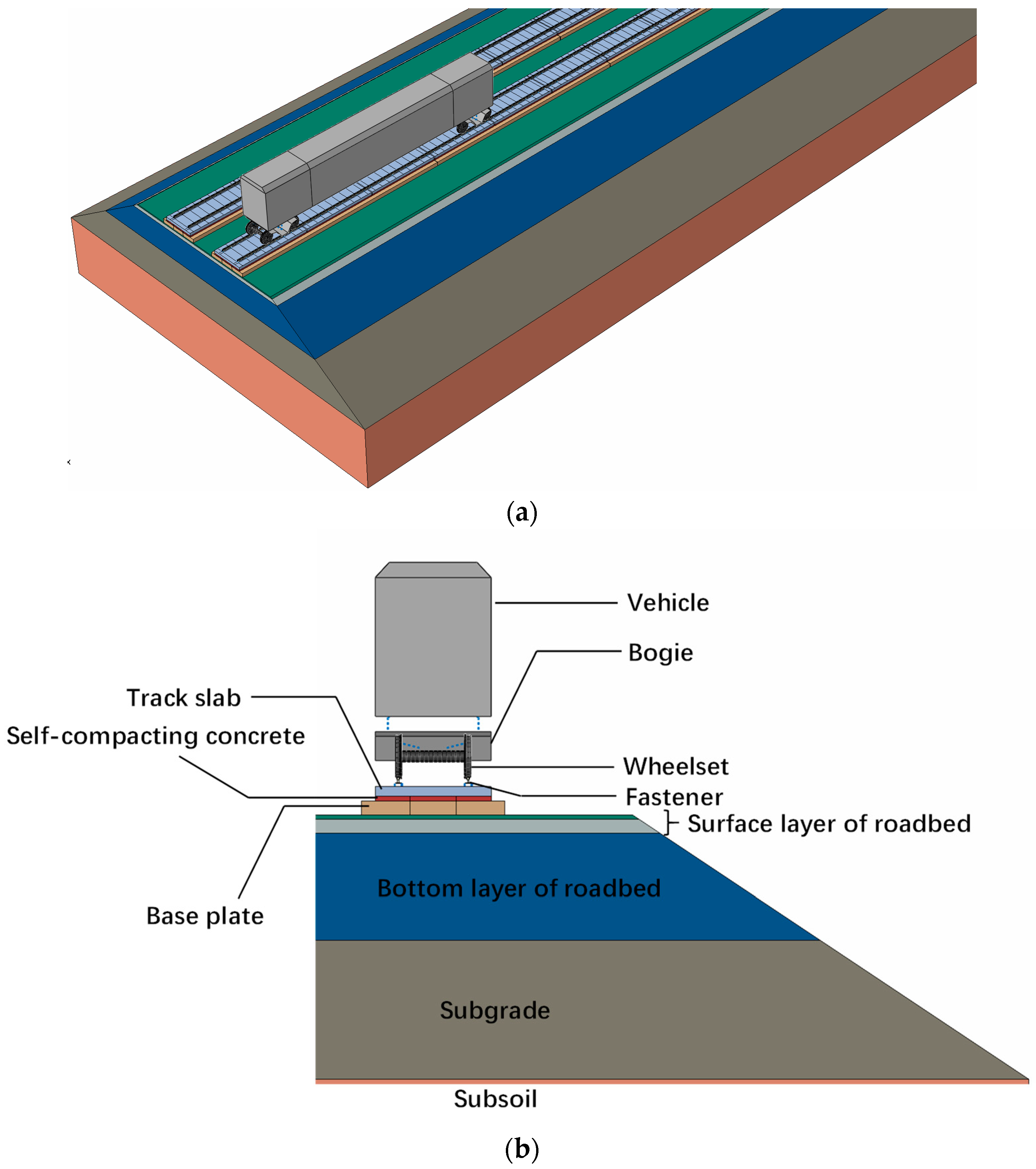
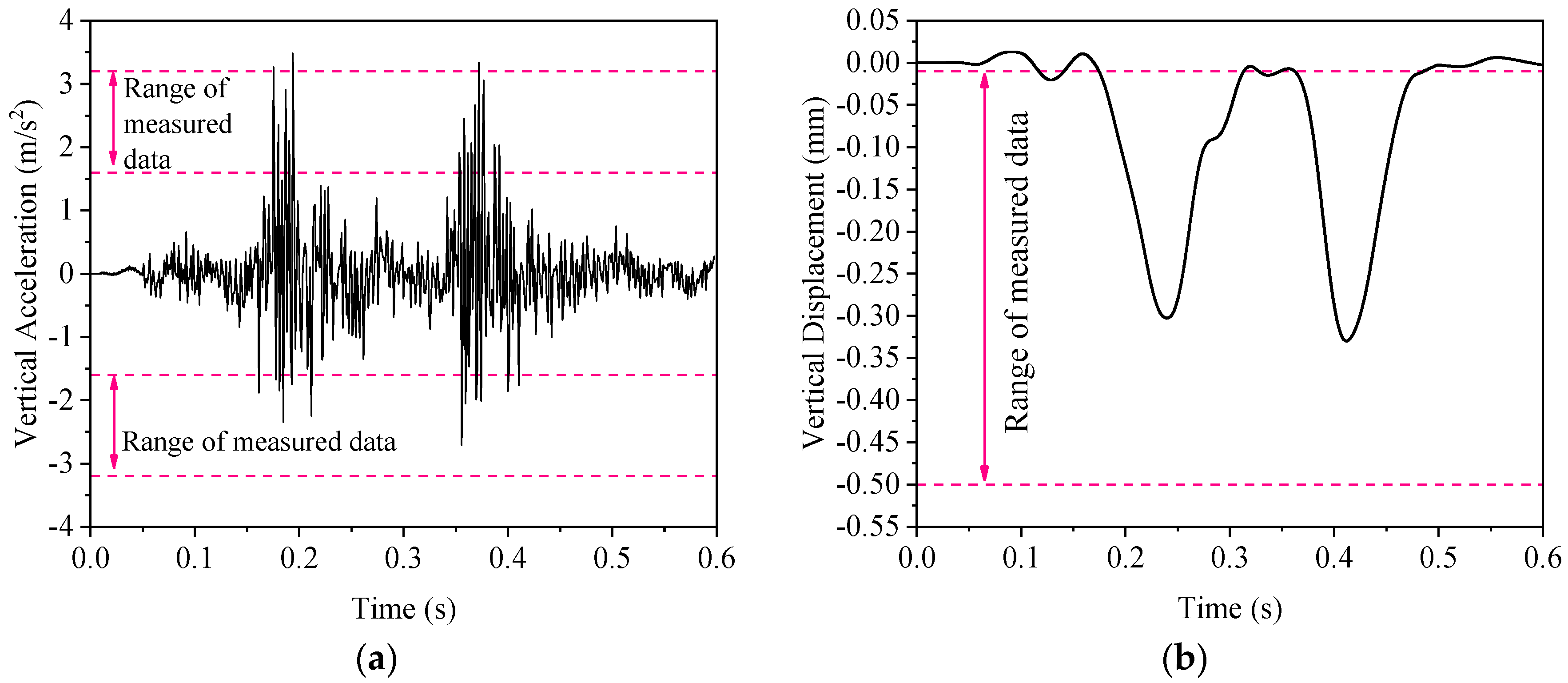

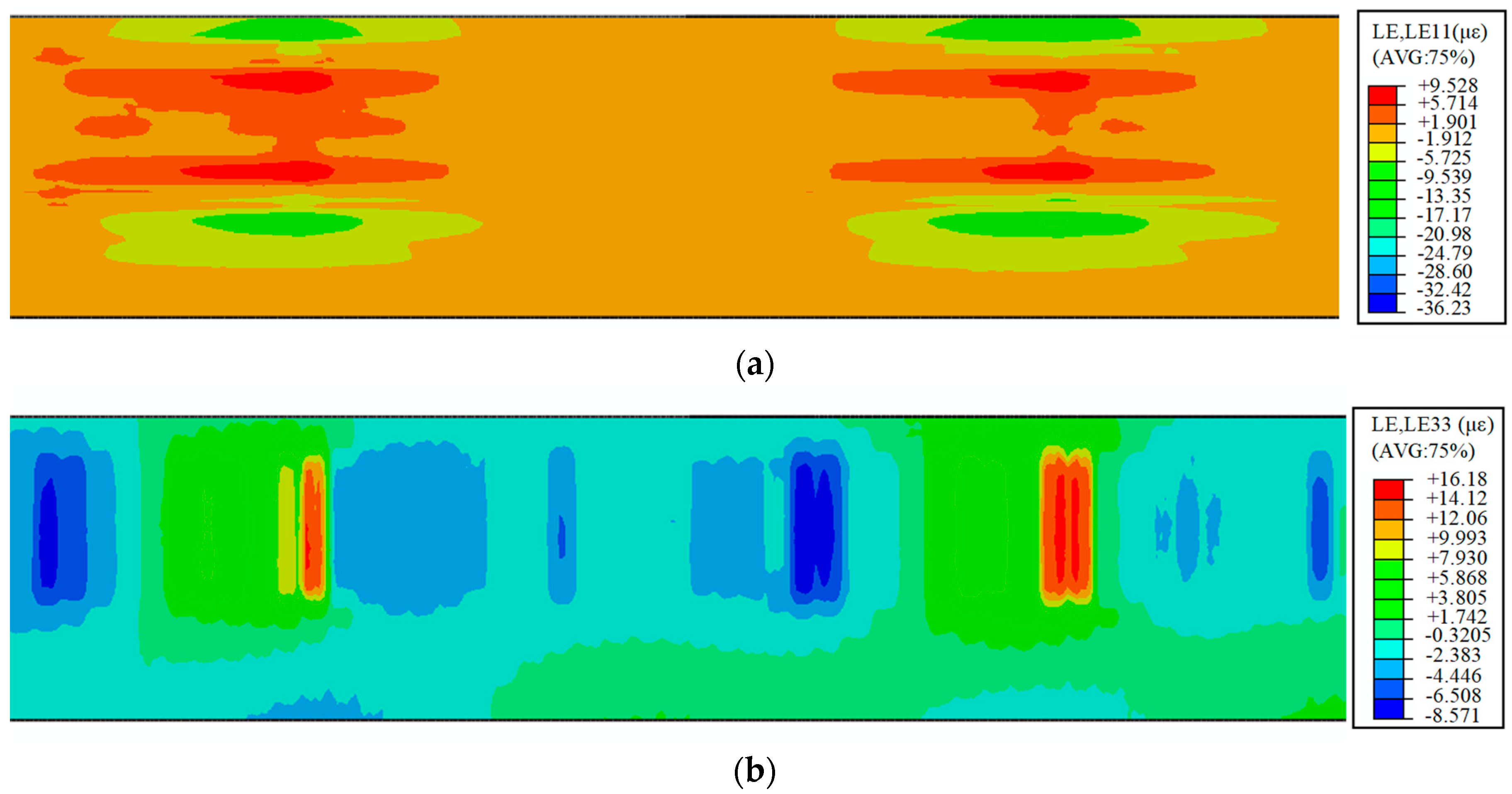
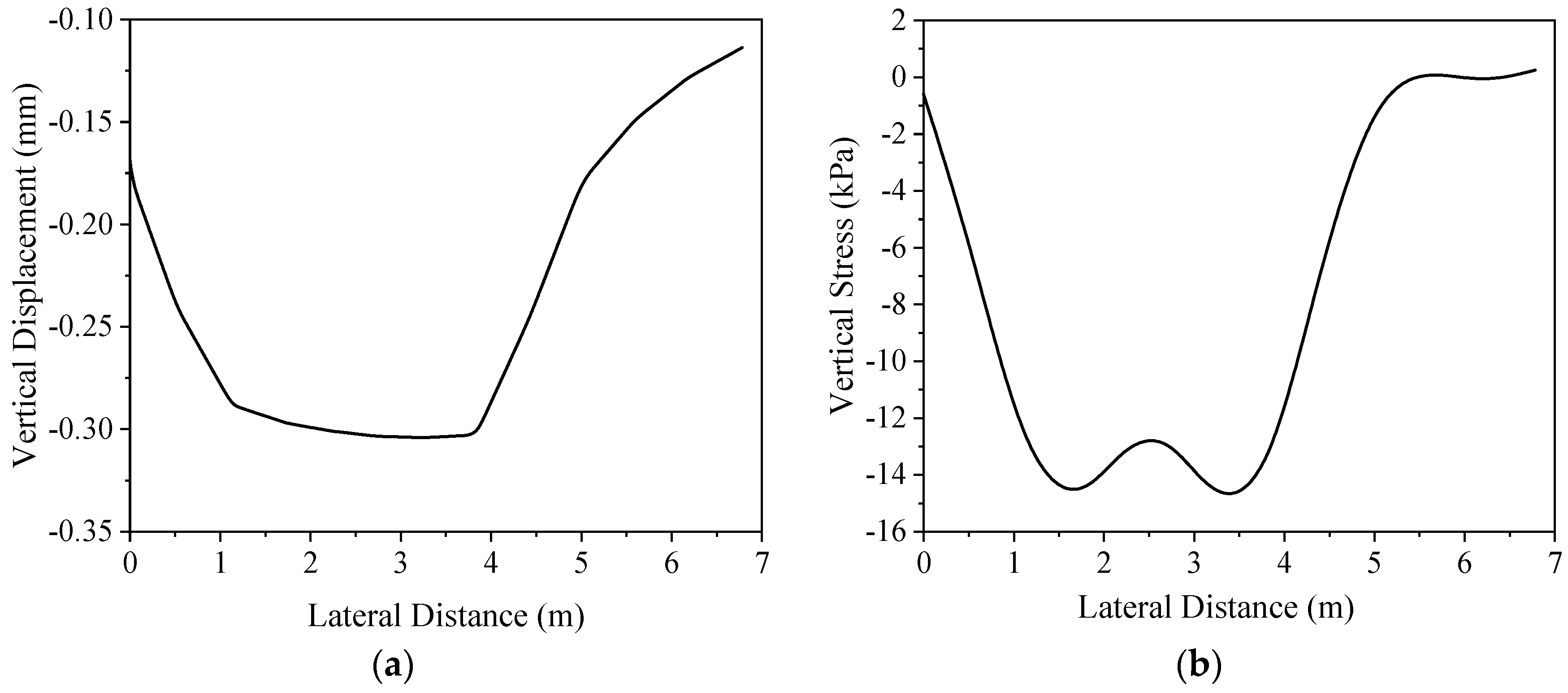
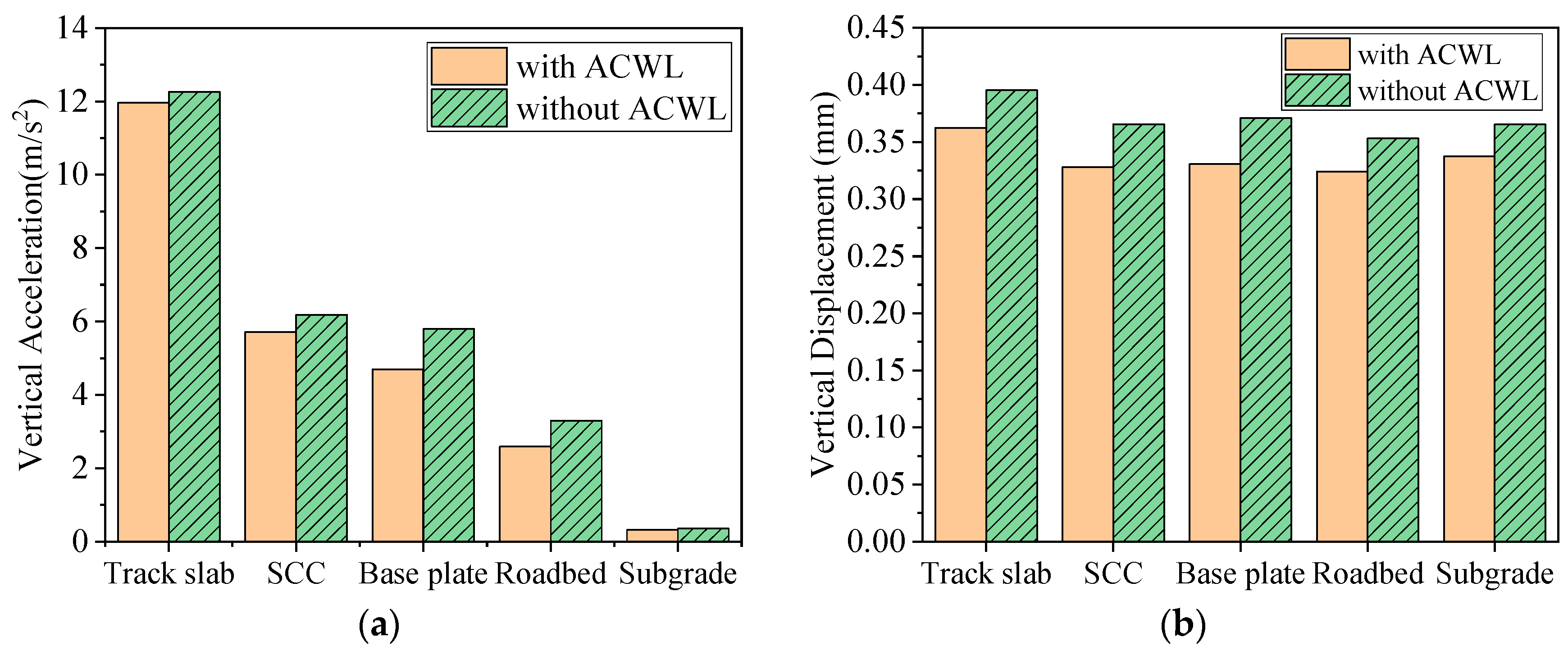


| Properties | Test Results | Technical Requirements | Test Method |
|---|---|---|---|
| Penetration (25 °C, 100 g, 5 s) (0.1 mm) | 71.4 | 60–80 | T0604 |
| Penetration index | 1.6 | ≥0.5 | T0604 |
| Ductility at 5 °C (cm) | 41 | ≥30 | T0605 |
| Softening Point (°C) | 90.2 | ≥80 | T0606 |
| Dynamic viscosity at 175 °C, Pa·s | 1.245 | ≤1.5 | T0625 |
| Test | Test Result (Unit) | Measured Value | Technical Requirement |
|---|---|---|---|
| Rutting test | Dynamic stability (cycle/mm) | 3231 | ≥2400 |
| Fatigue Test | Fatigue life (×104 Cycle) | 122.5 | ≥20 |
| Low temperature bending test | Failure strain (με) | 3356 | ≥3000 |
| Water Stability Test | Residual stability (%) | 92.9 | ≥85 |
| TSR (%) | 91.9 | ≥80 |
| i | 1 | 2 | 3 | 4 | 5 | 6 | 7 | 8 | 9 | 10 | 11 |
|---|---|---|---|---|---|---|---|---|---|---|---|
| τi(s) | 10−6 | 10−5 | 10−4 | 10−3 | 10−2 | 10−1 | 1 | 101 | 102 | 103 | 104 |
| Ei(MPa) | 3547.0 | 3599.5 | 4204.2 | 4526.4 | 4414.1 | 3405.5 | 1825.8 | 685.8 | 264.9 | 77.1 | 84.0 |
| Ee(MPa) | 75.3 | ||||||||||
| Track Components | Modulus (MPa) | Poisson Ratio | Density (kg/m3) |
|---|---|---|---|
| Rail | 210000 | 0.3 | 7800 |
| Track slab | 36000 | 0.2 | 2500 |
| SCC | 32500 | 0.2 | 2500 |
| Base plate | 32500 | 0.2 | 2500 |
| ACWL | Table 3 (20 °C) | 0.3 | 2500 |
| Surface layer of roadbed | 200 | 0.3 | 2000 |
| Bottom layer of roadbed | 140 | 0.25 | 1800 |
| Subgrade | 110 | 0.25 | 1700 |
| Subsoil | 80 | 0.25 | 1600 |
| Dynamic Response Indexes | Load Case 1 | Load Case 2 | Load Case 3 | |
|---|---|---|---|---|
| Vertical stress (kPa) | 20.18 | 19.94 | 14.28 | |
| Vertical displacement (mm) | 0.37 | 0.33 | 0.26 | |
| Vertical acceleration (m/s2) | 3.87 | 3.50 | 3.03 | |
| Tensile strain (με) | Lateral | 9.53 | 6.81 | 5.00 |
| Longitudinal | 16.18 | 14.39 | 10.63 | |
© 2019 by the authors. Licensee MDPI, Basel, Switzerland. This article is an open access article distributed under the terms and conditions of the Creative Commons Attribution (CC BY) license (http://creativecommons.org/licenses/by/4.0/).
Share and Cite
Zhou, J.; Chen, X.; Fu, Q.; Xu, G.; Cai, D. Dynamic Responses of Asphalt Concrete Waterproofing Layer in Ballastless Track. Appl. Sci. 2019, 9, 375. https://doi.org/10.3390/app9030375
Zhou J, Chen X, Fu Q, Xu G, Cai D. Dynamic Responses of Asphalt Concrete Waterproofing Layer in Ballastless Track. Applied Sciences. 2019; 9(3):375. https://doi.org/10.3390/app9030375
Chicago/Turabian StyleZhou, Jie, Xianhua Chen, Qinghong Fu, Gang Xu, and Degou Cai. 2019. "Dynamic Responses of Asphalt Concrete Waterproofing Layer in Ballastless Track" Applied Sciences 9, no. 3: 375. https://doi.org/10.3390/app9030375
APA StyleZhou, J., Chen, X., Fu, Q., Xu, G., & Cai, D. (2019). Dynamic Responses of Asphalt Concrete Waterproofing Layer in Ballastless Track. Applied Sciences, 9(3), 375. https://doi.org/10.3390/app9030375





